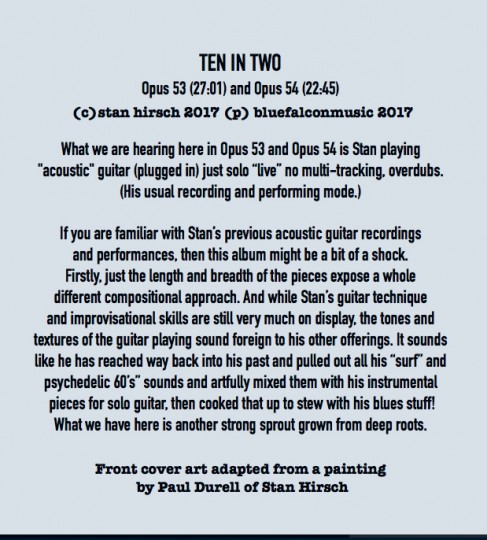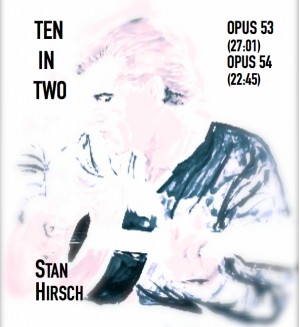TEN IN TWO
TEN IN TWO
What we are hearing here in Opus 53 and Opus 54 is Stan playing
"acoustic" guitar (plugged in) just solo "live" no multi-tracking, overdubs.
(His usual recording and performing mode.)
If you are familiar with Stan's previous acoustic guitar recordings
and performances, then this album might be a bit of a shock.
Firstly, just the length and breadth of the pieces expose a whole
different compositional approach. And while Stan's guitar technique
and improvisational skills are still very much on display, the tones and
textures of the guitar playing sound foreign to his other offerings. It sounds
like he has reached way back into his past and pulled out all his "surf" and
"psychedelic 60's" sounds and artfully mixed them with his instrumental
pieces for solo guitar, then cooked that up to stew with his blues stuff!
What we have here is another strong sprout grown from deep roots.
(Further down on this page you can read about Stan's "soundtracks".)
Sound Tracks
I started "experimenting" with what I have always called "sound tracks' in the mid- 60's. I had two reel to reel tape recorders. I would record a part on one recorder, then record another part on`the 2nd recorder while that first part was playing back. So then I would have two parts. I would just keep doing that adding a lot of different parts. I had all kinds of strange instruments I would pick up and use. Most were just "tourist" souvenirs people had picked up from around the world and then sold at a garage sale.
Then of course multi-track recorders came on the market and you could just bounce tracks. But I never could afford one till they came out in cassette format. (I also happened to have better paying gigs by that time.)
So I started doing the multi-tracking thing again in the mid-90's.
The sound track on this page "Time Traveler" was made that way in the mid-90's. Again using all acoustic instruments like tambourine, tablas,harmonicas, simple wooden flutes, percussion of all sorts and obviously guitars. The idea behind this work was that I imagined myself traveling through space and time (here on earth) and entering different scenes where people from different cultures were making music.
But I lost interest in multi-tracking because it takes up too much of my energy in technical sound engineering work rather than being focused on music playing and composition ability.
That is why `for the last 20 years or so all my recordings are "live" unedited solo guitar recordings. And I always use a very unfiltered studio sound to record my blues and jazz and also my acoustic solo instrumental guitar pieces. So it all sounds very much like you would hear me sitting down on your porch and pulling out a guitar and playing.
But I have been wanting to record some longer works for awhile now. I bought a synthesizer thinking I would multi-track with all variety of synthesized instrument sounds. This way I would have an entire "Orchestra (plus)" in my hands! But again, that involved so much technical engineering and also took away much of the spontaneity and improvisation. And although playing with all those different instrument voices is really exciting and inspiring, getting it all together in a large "scored" form with all the arrangement of parts and the recording and mixing of all those involved too much paper work and engineering work for me.
Also, nothing can really match the freedom of "one track/ one take" solo playing. I can take it anywhere and nobody or no other part has to follow me. Nothing else as to "sync" with me.
Now I had used many "stomp boxes" and all manner of guitar effects during my 60's and early 70's rock days. (Think Psychedelic!) But as a blues, folk, jazz player I had given most of those up. But some of the equipment I have been using (Think Computers!) had a lot of these "digital effects" (sound processors) built int them. So I started messin' with some of them and thought they would work for my larger pieces. They would give me a large palette with many colors. Then I could still just play "one track/one take".
In other words, I found that by using digital processing effects (delay, reverb, etc),I could still record "live" (no multi-tracking, overdubs, etc) but then have a nice variety of different sound shapes to work. To take the place of more "voices" and more instruments. So these digital processors allow me to think a bit more as if I am working an orchestra.
Opus 53 and Opus 54 here are my first large works created that way. (I did get familiar with the recording techniques and the sounds while recording my "Emergence" project last year.)
So again; What you are hearing here in Opus 53 and Opus 54 is me playing "acoustic" guitar (plugged in) just solo live one take using a different effect for each musical "movement".
All the music herein was recorded with one acoustic six string guitar with (elec. pickup) plugged into an Apple laptop computer. (Using a Apogee Jam interface and the computers built in Garage Band recording software.) The recording was then mastered using the Audacity "freeware". There was no overdubbing of parts or multi-tracking as all "parts"were played "live" on one guitar. All the variation in tone and texture is simply the use of standard digital processing.
Both are composed "live" using previously written themes ("songs").Opus 53 is three of my shorter pieces combined into a larger piece. Opus 54, although a shorter piece, is actually four different themes. But, it is way more and way less than that.
Together all those previously written works provide me with themes (melodies, chords and rhythms). Then while composing the larger pieces they are used as a basic catalyst for this larger work. They are spread out and reconstituted. (In "Classical" compositions they call this variations and recapitulations.) Each "movement" in these works is defined with a different tone/texture in the sound. Just as in listening to a "classical" concerto, It is easy to distinguish the different movements. Opus 53 has eight and Opus 54 has nine. Again, all played "live" "one track", one solo guitar.
-Stan Hirsch, (Recorded Jan. 2017)






